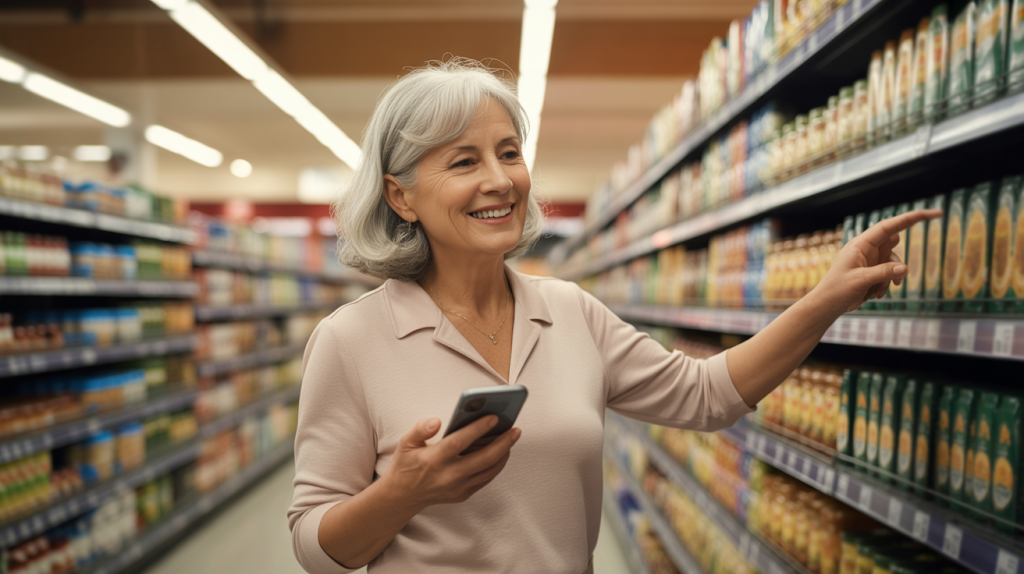For years, the words “Buy One, Get One Free” were like a siren song to me. They whispered promises of smart shopping, of doubling my bounty for half the effort, of being a savvy consumer who knew how to work the system. I’d walk into the grocery store, my eyes scanning the aisles for those magical BOGO tags, and each one I snagged felt like a little victory. My cart would fill up, and I’d feel a sense of pride. Look at all this food, all these products, and I got so much of it for free! Or so I thought.
My journey away from the allure of BOGO deals wasn’t a sudden revelation, but a slow, dawning realization, punctuated by overflowing cupboards, wasted food, and a nagging feeling that my “savings” weren’t quite adding up the way I imagined. This is my story of how I broke free from the BOGO spell and discovered a more mindful, and ultimately more rewarding, way to manage my grocery budget and my home.
My Early Love Affair with BOGO: The Thrill of the “Free”
I remember my early days as a dedicated BOGO hunter vividly. It probably started when I was managing a household on a tighter budget, trying to make every dollar stretch. The grocery store circulars were my treasure maps, and those BOGO deals were the buried gold. Cereal was a common one. If my favorite brand of bran flakes was BOGO, I wouldn’t just get two boxes; I’d get four, or even six if the expiration dates allowed. “We’ll definitely eat it all,” I’d tell myself. Pasta, canned tomatoes, coffee, cleaning supplies – you name it, if it was BOGO and something we used, it went into my cart.
There was a genuine thrill in it. It felt like I was outsmarting the stores. Getting two items for the price of one seemed like the ultimate grocery hack. My pantry shelves would be impressively stocked, a visual testament to my shopping prowess. Friends would sometimes comment on how well-stocked I always was, and I’d puff up a little, explaining my BOGO strategy. I genuinely believed I was at the peak of my smart discount game.
I’d plan my meals around what was on BOGO that week. If chicken breasts were buy one, get one, then chicken dishes dominated the menu. If it was a particular brand of yogurt, then everyone in the house was eating that yogurt for breakfast, snacks, and maybe even dessert. I adapted. I was flexible. All in the name of that glorious “free” item.
The cashiers often knew me, and sometimes they’d even point out a BOGO I might have missed. I felt like part of an exclusive club of savvy shoppers. The dopamine hit of seeing that discount applied at the register, watching the total drop – it was addictive. I wasn’t just buying groceries; I was winning a game.
The First Cracks in My BOGO Paradise: When “Savings” Started to Cost Me
The first inklings that my BOGO obsession might have a downside came subtly. It wasn’t a single event, but rather a series of small, uncomfortable observations that started to chip away at my conviction.
The Pantry of No Return: A Monument to Expired Deals
My once impressively stocked pantry started to feel… cluttered. Then, it became overwhelming. I remember one Saturday morning, I decided to organize it. As I pulled items out, I started noticing the expiration dates. A can of artisanal olives, bought on a BOGO deal months ago for a dinner party that never happened, was six months past its prime. Two boxes of specialty crackers, companions to a BOGO cheese I’d since forgotten, were stale. The “backup” bottle of salad dressing, the free one, had separated into an unappetizing concoction.
It wasn’t just a few things. I found myself making a pile of expired or nearly-expired BOGO items that was embarrassingly large. There were three unopened jars of a gourmet salsa – “We’ll have a taco night!” I’d declared – all expiring within the next month. Four boxes of a new flavor of herbal tea, the “free” ones from a BOGO deal, sat untouched because, as it turned out, no one in the family particularly liked that flavor. The “extra” bag of lentils, the “bonus” jar of pickles – the list went on.
The feeling was awful. It was a mix of guilt over the waste, frustration with myself, and a dawning awareness of the money I had effectively thrown away. Each expired item represented not a saving, but a loss. The “free” item wasn’t free if it ended up in the trash. I had spent money on the first item to get the second, and if the second (or sometimes even both) went unused, where was the value? My pantry, once a source of pride, now felt like a monument to my misjudgments.
The Lure of the Unwanted: Buying for the Deal, Not the Need
Another unsettling pattern I began to notice was how often I bought things I didn’t truly need, or even particularly want, simply because they were on a BOGO offer. I recall a specific instance with a brightly colored sports drink. I rarely bought such things, preferring water or juice. But there it was: Buy One large multi-pack, Get One Free. Suddenly, my mind was racing with justifications: “It’ll be good for when the grandkids visit,” or “Maybe I’ll start exercising more and need the electrolytes.”
So, I bought them. Two huge packs of sugary drinks. They sat in the garage for months. The grandkids preferred their usual juice boxes. My ambitious exercise kick never quite materialized in a way that necessitated neon-colored hydration. Eventually, I ended up donating most of them to a local youth event, just to get them out of the house. While a donation is a good thing, the initial purchase wasn’t driven by a genuine need or desire, but by the magnetism of the BOGO tag.
This happened with food items too. A brand of cookies I wasn’t fond of, but “Hey, it’s BOGO!” A new type of frozen meal that sounded intriguing on the packaging but didn’t quite live up to the hype – and now I had two. I was letting the deals dictate my choices, rather than my actual preferences and needs dictating what deals I looked for. The power dynamic had shifted; the deals were controlling me, not the other way around.
The Mental Load of “Too Much Stuff”
Beyond the financial waste and the consumption of unwanted items, there was another, less tangible cost: the mental load. My house, particularly the kitchen and storage areas, felt perpetually full. Finding space for the latest BOGO haul became a frustrating game of Tetris. Trying to remember what I had, where it was, and when it expired, became a low-level stressor.
Meal planning, which should have been simplified by a well-stocked pantry, sometimes became more complicated. I felt an obligation to use up all these BOGO items before they went bad. This pressure to consume could lead to monotonous meals or forcing myself to eat something I wasn’t really in the mood for, just to avoid waste. It felt less like abundance and more like a burden.
I started to realize that my quest for “free” stuff was cluttering not just my physical space, but my mental space too. The “savings” I was chasing were coming at the cost of peace of mind and a sense of order in my home. I began to wonder if there was a better way, a way to be truly smart about my grocery spending without drowning in excess.
The Day the BOGO Bubble Burst: My Wake-Up Call
The real turning point, the moment the BOGO bubble truly burst for me, came during a particularly challenging month. My husband, John, had some unexpected medical bills, and our budget, usually comfortable, became quite tight. We needed to scrutinize every penny. It was time for a serious financial deep-dive, and that included our grocery spending, which had always been my domain.
I sat down one evening with a pile of grocery receipts from the past few months, a notebook, and a calculator. My goal was to see where our money was really going. As I meticulously went through each receipt, highlighting the BOGO deals, a disturbing picture emerged. Yes, I was getting items “free,” but my overall grocery bills were still quite high. Sometimes, the “buy one” price of a BOGO item was inflated compared to its regular price, or compared to a competitor’s brand that wasn’t on sale.
Then came the food waste audit. Spurred by my earlier pantry cleanout, I started keeping a rough tally for a week of anything we threw out that had been purchased as part of a deal, especially a BOGO. The amount was sobering. A half-eaten container of BOGO cottage cheese that went sour. The second loaf of BOGO bread that grew mold before we could get to it. Vegetables bought in a BOGO pack where half wilted in the crisper drawer.
The starkest moment came when I was cleaning out the freezer. Tucked in the back was a large, frost-covered package. It was two family-sized lasagnas, bought on a BOGO deal nearly a year prior. “Perfect for busy weeknights!” I had thought. We’d eaten one, and it was fine, but not amazing. The second one just sat there, forgotten, until it was a fossilized relic of a “good deal.” Seeing that, combined with the tight budget we were facing, hit me hard. It wasn’t just food; it was wasted money, wasted resources, wasted energy.
I felt a profound sense of foolishness, almost like I’d been duped by my own enthusiasm. The “thrill of the hunt” had blinded me to the actual cost. John, bless his patient soul, never criticized my BOGO habit directly, but he did gently point out, “Honey, maybe we have too much pasta?” when I came home with yet another BOGO haul of spaghetti while three other varieties sat in the cupboard.
That evening, staring at my notes and the discarded lasagna box, I made a conscious decision. Something had to change. My approach to grocery shopping, my relationship with deals, needed a complete overhaul. It wasn’t about depriving myself; it was about being genuinely smarter, more intentional, and truly saving money, not just accumulating stuff.
Forging a New Path: My Journey to Smarter Grocery Shopping
Making the shift away from my BOGO-centric shopping habits wasn’t an overnight transformation. It was a process, a learning curve filled with conscious effort, a few stumbles, and ultimately, a lot of rewarding discoveries. I had to unlearn old habits and cultivate new ones.
Taking Stock: The Hard Look at My Habits (and My Receipts)
The first step was honesty. Brutal honesty. My receipt analysis became a regular ritual for a while. I didn’t just look at the total; I looked at what I bought, why I bought it, and whether we actually used it all. I started asking myself tough questions before putting something in my cart, especially if it was a multi-buy offer:
- Do I, or we, genuinely need two (or more) of these right now?
- Realistically, will we consume all of it before it expires or loses quality?
- Is this a product I would happily buy at its regular, single-item price?
- Do I have adequate, easily accessible storage space for the extra item(s)?
- Is this brand truly my preference, or am I settling because of the deal?
These questions became my new filter. It was surprising how often the answer to one or more of them was “no,” especially when it came to BOGO deals. I also started a simple “food waste log” in a small notebook I kept in the kitchen. Just a quick note of what got thrown out and why. Seeing it in writing was a powerful motivator.
My New Toolkit: Beyond the BOGO Siren Song
Armed with this new awareness, I began to explore other ways to save money on groceries – strategies that focused on actual need and value, not just volume. These became my essential grocery hacks and smart discount techniques:
Unit Pricing Became My Best Friend: This was a game-changer. I’d always vaguely known about unit prices (the price per ounce, per pound, per item, etc., usually in small print on the shelf tag), but I hadn’t paid them enough attention. I started meticulously comparing them. Often, I found that a larger, single package of a store brand was significantly cheaper per unit than the name-brand BOGO deal. Or sometimes, buying two of a smaller-sized item, even without a BOGO, was a better deal than the “buy one large, get one large free” offer if we couldn’t use all of the large size.
The Power of a Detailed List (and Sticking to It!): I always made a shopping list, but BOGO deals were my Kryptonite; they’d lure me off-course. I recommitted to my list with a new ferocity. If it wasn’t on the list, I had to have a very compelling reason to buy it. This meant planning meals more carefully for the week, checking what I already had in the pantry, fridge, and freezer, and only listing what was truly needed. This significantly cut down on impulse BOGO purchases.
Embracing Store Brands: I used to be a bit of a brand snob for certain items. But with my new focus on value, I started experimenting more with store brands. I was pleasantly surprised to find that for many staples – canned goods, dairy products, flour, sugar, even some frozen foods – the quality was often indistinguishable from the more expensive name brands. And the savings were consistent, not dependent on a BOGO cycle.
Strategic Use of Sales and Coupons (for Single Items): I didn’t give up on discounts entirely, of course! But I shifted my focus. I looked for sales on individual items I actually needed. I became more diligent about using digital coupons clipped from store apps, but only for products that were already on my list. The key was that the discount applied to a single item I intended to buy anyway, not forcing me to buy two to get the “deal.”
Smaller, More Frequent Trips (Sometimes): Instead of one massive weekly shop designed to load up on BOGOs, I sometimes found it better to make a smaller mid-week trip for fresh produce or specific items I’d run out of. This helped reduce waste from overbuying perishables and kept me from feeling pressured to “stock up” unnecessarily.
Understanding “Loss Leaders”: I learned that stores often advertise certain items at a very low price (sometimes even at a loss to them) just to get you in the door, hoping you’ll buy other, higher-margin items. I started paying attention to these “loss leaders,” and if it was something I genuinely needed (like milk or eggs), I’d happily pick it up, but I wouldn’t let it be an excuse to fill my cart with other things, especially BOGOs I hadn’t planned for.
Resisting Temptation: Learning to Say No
This was the hardest part. The BOGO habit was deeply ingrained. For the first few months, walking past a compelling BOGO display felt like walking past a plate of my favorite cookies while on a diet. My inner voice would scream, “But it’s FREE!”
I had to develop coping mechanisms. Sometimes, I’d literally walk away, take a deep breath, and consult my list and my mental checklist of questions. I’d remind myself of the cluttered pantry, the wasted food, the feeling of being overwhelmed by stuff. I’d visualize my clearer shelves and the actual savings in my bank account from more mindful spending.
There were times I slipped up. I’d cave and buy a BOGO deal, only to regret it later when one of the items sat unused. But each slip-up was a learning experience, reinforcing my resolve. Gradually, the urge lessened. The “thrill” of the BOGO was replaced by the quiet satisfaction of making a truly smart choice for my household and my budget.
Life After BOGO: The Unexpected Freedoms
The changes I made to my grocery shopping habits, particularly my move away from compulsive BOGO buying, have had a ripple effect throughout my life, bringing benefits I hadn’t even anticipated.
A Calmer Kitchen, A Clearer Mind
The most immediate and visible change was in my kitchen. My pantry is no longer a source of stress. It’s organized. I know what’s in there. I can find things easily. My refrigerator isn’t crammed with items nearing their expiration date. This physical decluttering had a surprising impact on my mental state. I feel calmer, more in control. Meal planning is easier and more enjoyable because I’m working with ingredients I’ve mindfully chosen, not ones I feel obligated to use up.
There’s a certain peace that comes from knowing you have what you need, and not an overwhelming excess of what you might need, or what you thought was a good deal. The mental energy I used to spend managing surplus, worrying about waste, and strategizing BOGO acquisitions is now freed up for other, more pleasant things.
Genuine Savings and Better Quality
Counterintuitively, by buying less “free” stuff, I started saving more money. My overall grocery bills decreased. This wasn’t just because I was avoiding the cost of the “buy one” item in a BOGO deal; it was because I was eliminating waste. Every item thrown out is money down the drain. By buying only what we would realistically use, that drain was effectively plugged.
Furthermore, because I wasn’t always chasing the BOGO, I felt freer to choose items based on quality, not just quantity or brand loyalty tied to a deal. Sometimes, this meant buying a slightly more expensive single item that I knew we’d enjoy more or that was healthier, rather than two of a mediocre BOGO product. The overall satisfaction with what we were eating increased. I could focus on buying fresh, seasonal produce when it was at its best and most affordable, rather than being swayed by a BOGO on something out of season or less appealing.
The Joy of Intentional Living
This journey with grocery shopping has become part of a larger shift towards more intentional living. It taught me the value of questioning consumer impulses, of looking beyond the surface appeal of a “deal,” and of understanding the true cost of my choices – not just in dollars, but in terms of waste, space, and mental well-being.
This mindset has extended to other areas of my life. I’m more thoughtful about purchases in general, whether it’s clothing, household goods, or gifts. I ask myself similar questions: Do I truly need this? Will it add value to my life? Or is it just a momentary desire fueled by clever marketing?
My Personal BOGO Philosophy Now: It’s Not a “Never,” It’s a “Hardly Ever”
I want to be clear: I haven’t sworn off BOGO deals entirely, as if they are inherently evil. There are rare occasions when a BOGO offer makes perfect sense for me. For example, if it’s a non-perishable item that I use very regularly, that has a long shelf life, that I have ample space for, and that I would be buying anyway at its full price – then, yes, I might consider it. If my favorite coffee, which I drink daily and lasts for months, is BOGO, and I have the pantry space, I might get it. If the specific brand of toothpaste my dentist recommends and my husband and I both use is BOGO, that’s a sensible purchase.
The difference is that now, these are highly calculated decisions, not impulse grabs. I approach BOGO deals with extreme caution and a healthy dose of skepticism. My default answer is “no,” and the deal has to work very hard to convince me otherwise, passing all my personal criteria.
More often than not, I find that other discount strategies serve me better: looking for straightforward percentage-off sales on single items, using loyalty card points for direct discounts, carefully comparing unit prices, and opting for store brands. These methods give me more control and align better with my goal of buying only what I truly need and will use.
Lessons I Carry With Me: More Than Just Groceries
My journey from BOGO enthusiast to BOGO avoider has taught me so much, and the lessons extend far beyond the grocery aisles. It’s been a practical education in mindful consumption and personal finance that I believe is valuable at any stage of life.
I learned that “free” often has hidden costs – the cost of storage, the cost of waste if unused, the cost of buying something you didn’t really want in the first place. I learned to look past the exciting marketing and analyze the true value of an offer. Marketing is designed to tap into our desires and our psychology, and understanding that helped me feel less susceptible to its pull.
I discovered that true thrift isn’t just about grabbing every apparent bargain; it’s about resourcefulness, planning, and making conscious choices that prevent waste and align with your actual needs. It’s about the long-term savings, not just the immediate gratification of a “deal.”
Most importantly, I learned the power of awareness and intention. By simply paying closer attention to my habits, my spending, and the consequences of my choices, I was able to make significant changes that have improved my finances, reduced stress, and brought a greater sense of order and calm to my home. It’s a continuous journey, of course, but I no longer feel like I’m being played by the deals. Instead, I feel empowered to make choices that genuinely serve me and my family.
So, the next time you see that tempting “Buy One, Get One Free” sign, I encourage you to pause and ask yourself a few honest questions. My experience taught me that sometimes, the smartest discount is the one you walk away from, leading you to a path of more thoughtful spending and, ultimately, greater peace of mind. And for me, that’s a value no BOGO can ever match.















